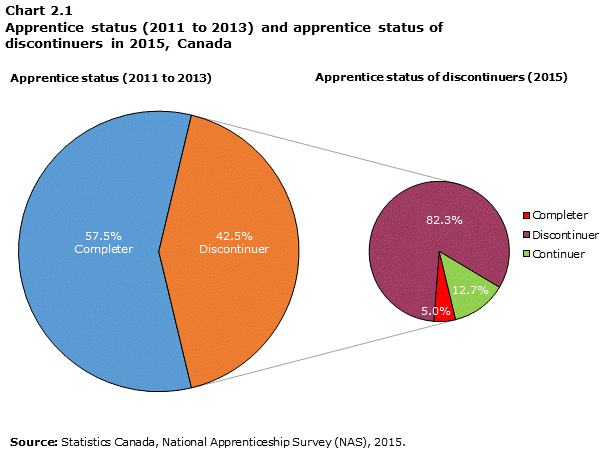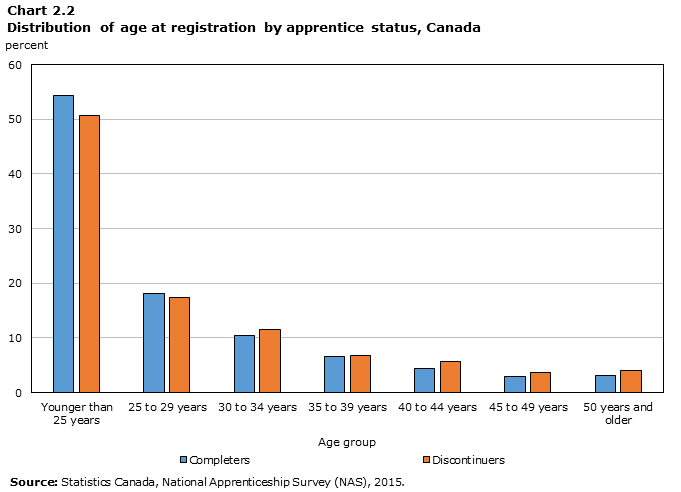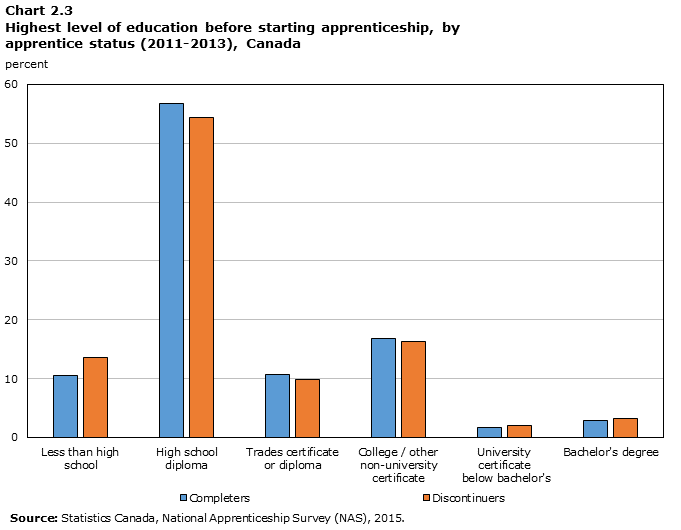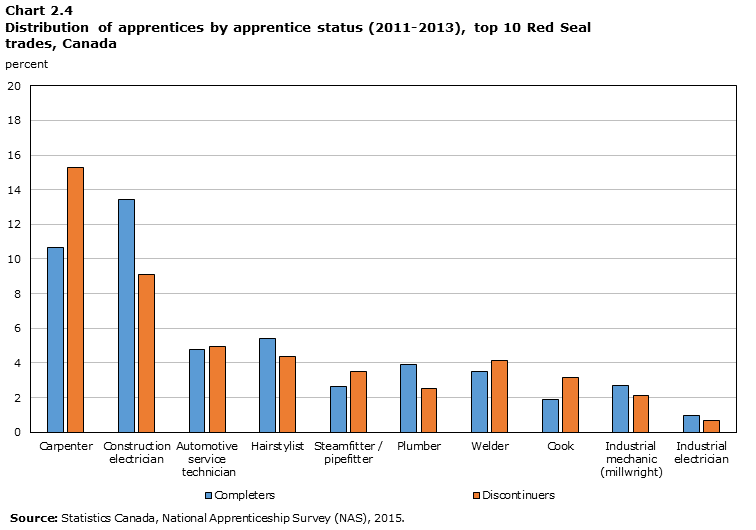National Apprenticeship Survey: Canada Overview Report 2015
Section 2 Profile of apprentices
Archived Content
Information identified as archived is provided for reference, research or recordkeeping purposes. It is not subject to the Government of Canada Web Standards and has not been altered or updated since it was archived. Please "contact us" to request a format other than those available.
The skilled trades are critical to Canada’s economic growth and long-term prosperity. Numerous support programs, including grants, loans, tax credits, and Employment Insurance (EI) benefits during in-school training, have been established to encourage Canadians to learn a trade. The focus and success of these programs, in turn, relies on an awareness of which Canadians require support to complete their training.
One of the goals of the 2015 NAS is to provide a socio-demographic profile of apprentices who either complete or discontinue their apprenticeship programs. This section highlights the socio-demographic characteristics of completers and discontinuers, including: age, marital status, sex, visible minority status, immigrant status, Aboriginal identity, province or territory of registration and highest level of education attained. Detailed information on these characteristics is provided in Table A.2.1 (Appendix A).
In order to encourage Canadians to register in and complete apprenticeship programs, it is also useful to know more about the programs themselves. This section provides some of the 2015 NAS data on the number of apprentices registered in various Red Seal trades as well as the number of years apprentices remained in their apprenticeship programs.
Key findings
- The majority (95.2%) of apprentices who completed an apprenticeship program became certified.
- Almost 13% of discontinuers subsequently became continuers in an apprenticeship program and another 5% had completed an apprenticeship at the time of the survey (2015).
- Looking at the apprentice’s profile when they started an apprenticeship program, it appears that young people (aged less than 25), males, Canadian-born, non-Aboriginal, and non-visible minorities were more highly represented.
- The majority (55.7%) of apprentices had a high school diploma as their highest level of education when starting an apprenticeship.
- The majority of apprentices (81.1% of discontinuers and 76.0% of completers) were in a Red Seal trade.
Apprentice status between 2011 and 2013 and subsequent apprenticeship activities
Among the 28,469 apprentices interviewed for the NAS, 57.5% were completers. Of those who completed their programs between 2011 and 2013, 95.2% completed with certification (Table A.2.2, Appendix A). Information was also collected on whether NAS apprentices took additional apprenticeship programs following the one they completed or discontinued between 2011 and 2013. Chart 2.1 provides a summary of NAS apprentices’ status between 2011 and 2013, as well as additional information about the 2015 apprentice status of NAS discontinuers (either in the same trade or a new trade). While the majority of apprentices who discontinued a program between 2011 and 2013 were still discontinuers in 2015 (82.3%), more than 1 in 10 were continuers in an apprenticeship program at the time of the survey (12.7%). Five percent of apprentices who had discontinued their programs between 2011 and 2013 had completed an apprenticeship program by 2015. Refer to Table A.2.2 (Appendix A) for detailed results.

Data table for Chart 2.1
| Percent | |
|---|---|
| Completer | 5.0 |
| Discontinuer | 82.3 |
| Continuer | 12.7 |
| Source: Statistics Canada, National Apprenticeship Survey (NAS), 2015. | |
Demographic characteristics of apprentices
Most apprentices (52.8%) were younger than 25 years old when they started an apprenticeship (Table A.2.1, Appendix A). The distribution of apprentices’ age at registration is shown in Chart 2.2 below. NAS completers were more highly represented in the youngest (younger than 25) age group than were discontinuers, while discontinuers were slightly more likely than completers to have registered at more advanced ages (50 years and older). The average age of registration for apprentices was 27.0.Note 1

Data table for Chart 2.2
| Completers | Discontinuers | |
|---|---|---|
| percent | ||
| Younger than 25 years | 54.3 | 50.7 |
| 25 to 29 years | 18.1 | 17.4 |
| 30 to 34 years | 10.5 | 11.5 |
| 35 to 39 years | 6.6 | 6.9 |
| 40 to 44 years | 4.4 | 5.7 |
| 45 to 49 years | 2.9 | 3.8 |
| 50 years and older | 3.1 | 4.1 |
| Source: Statistics Canada, National Apprenticeship Survey (NAS), 2015. | ||
When they started an apprenticeship program, most apprentices (63.9%) were single, while about one-third (33.2%) were married or living common-law (Table A.2.1, Appendix A). A small proportion of apprentices (2.7%) were separated or divorced and more than three quarters (77.0%) did not have a dependant under the age of 18.
While completers were more likely than discontinuers to be married or living common-law at the start of a program (34.6% and 31.4%, respectively), they were less likely than discontinuers to have dependants under the age of 18 (Table A.2.1, Appendix A). Discontinuers were slightly more likely to be single (65.1%) separated or divorced (3.3%) than completers (62.9% of completers were single; 2.4% were separated or divorced).
The majority of apprentices were male (86.3%), Canadian-born (91.3%), and non-Aboriginal (93.7%), and did not belong to a visible minority group (91.8%) (Table A.2.1, Appendix A). Women were concentrated in a few trades, such as early childhood educator, hairstylist, and cook, and they comprised 13.7% of NAS apprentices. The results also show that women were, nonetheless, equally represented among completers and discontinuers (13.6% and 13.9%, respectively).
Representation of immigrants among NAS apprentices was low at 9% - Table A.2.1 (Appendix A) – given that they make up 20.6% of the Canadian population.Note 2 Moreover, discontinuers were slightly more likely than completers to be immigrants.
At 8.2% of NAS apprentices, the proportion of those belonging to a visible-minority groupNote 3 was also low compared with the group’s representation within the Canadian populationNote 4 at nearly 19%.
While Aboriginal people comprised about 4% of the overall Canadian population in 2011,Note 5 slightly more than 6% of apprentices identified as Aboriginal in the 2015 NAS.Note 6 When this proportion is broken down by Aboriginal group, results show that apprentices primarily identified as First Nations (3.2%) or Métis (2.9%), while a small proportion identified as Inuk (0.1%). Aboriginal apprentices comprised 8.2% of discontinuers and 4.9% of completers (Table A.2.1, Appendix A).
The 2015 NAS also collected information about apprentices’ disability status. The vast majority of apprentices (92.0%) reported not having a disability before registering for an apprenticeship and at the time of the survey, while 2.9% reported a disability at both points in time (Table A.2.1, Appendix A). The disability status of 5.1% of apprentices changed between the time of registration and the time of the survey, with the majority of this group developing a disability during this time period (4.2%). Only 0.9% had a disability when they registered for an apprenticeship but no longer had one in 2015. The results also show that completers were more likely than discontinuers to have no disability before starting their programs or at the time of the survey (94.1% and 89.2%, respectively). A higher percentage of discontinuers (4.0%) than completers (2.0%) had a disability at the start of an apprenticeship and still had a disability at the time of the survey. Apprentices who had discontinued their programs were also more likely than completers to have no disabilities at the start of an apprenticeship but to report a disability at the time of the survey (5.7% and 3.0%, respectively).
The provinces of registration with the largest proportion of apprentices were Ontario (27.8%), Alberta (24.5%), Quebec (20.0%), and British Columbia (17.3%). Together, five of the remaining provinces comprised about 10% of program registrants: Saskatchewan had 3.3% of registrants, followed by Manitoba (2.4%), Nova Scotia (1.6%), New Brunswick (1.4%), and Newfoundland and Labrador (1.3%). Prince Edward Island and the three territories accounted for about 0.5% of apprentice registrants combined. Detailed results can be found in Table A.2.3 (Appendix A).
Educational background of apprentices
The 2015 NAS collected information on apprentices’ highest level of education when they began their apprenticeships as well as their highest level of education at the time of the survey. These data are presented in Table A.2.4 (Appendix A).
Start of text box
Notes to readers: New derived variable for apprentices’ highest level of education at the time of the survey (2015)
A new derived variable was created for apprentices’ highest level of education at the time of the survey (2015) to address inconsistencies in the data. Three types of inconsistences were found. First, some apprentices reported a lower level of education at the time of the survey than at the time of registration (6.87% of cases). In these cases, the highest level of education at the time of registration was assigned to apprentices’ highest level of education at the time of the survey. Second, 5.2% of cases reported a trade certificate as their highest level of education at the time of the survey but had not completed an apprenticeship program (i.e., were discontinuers) and had reported an education level lower than a trade certificate at the time of registration. This was resolved by assigning apprentices’ education level at the time of registration as their education level at the time of the survey. Third, in some cases (4.39%) apprentices had completed an apprenticeship program but their highest level of education at the time of the survey was less than a trade certificate. For these apprentices, “trade certificate” was assigned as their highest level of education at the time of the survey.
End of text box
The majority of apprentices (55.7%) had a high school diploma as their highest level of education when they started an apprenticeship while about 12% had less than a high school diploma. Slightly more than 1 in 5 had some type of postsecondary certificate or diploma other than a trades certificate when they started an apprenticeship; this indicates that a skilled trade was likely not the first career choice for these apprentices. Nearly 17% had a college, CEGEP, or other non-university certificate or diploma and 3.0% held a bachelor’s degree. In addition, 1 in 10 already had a trades certificate or diploma.
Chart 2.3, below, summarizes apprentices’ highest level of education at the time of starting their programs by their apprentice status between 2011 and 2013. Discontinuers were more likely to begin an apprenticeship with less than a high school diploma than were completers (13.6% and 10.6% respectively), while completers were more likely than discontinuers to be high school graduates (56.7% and 54.4%, respectively). Similar proportions of completers and discontinuers were observed across the other levels of education.
At the time of the survey, 45.9% of NAS apprentices reported a trades certificate or a trades diploma as their highest level of education while more than 1 in 5 reported a college, CEGEP or other non-university certificate. Higher proportions reported a college, CEGEP or other non-university certificate or a bachelor’s degree as their highest level of education in 2015 than were reported as the highest level of education at the start of an apprenticeship program. It is worth noting that discontinuers were more likely to report these credentials in 2015 than completers. This suggests that some discontinuers pursued different postsecondary credentials after registering in an apprenticeship program.
The 2015 NAS collected data on whether apprentices’ parents had ever completed a trades certificate or a trades diploma (Table A.2.4, Appendix A). Overall, 33.6% of apprentices’ fathers had completed a trades certificate or a trades diploma at some point in their education, and 1 in 10 had mothers with the same credential. Similar proportions of completers and discontinuers had mothers and fathers who held trades certificates.

Data table for Chart 2.3
| Completers | Discontinuers | |
|---|---|---|
| percent | ||
| Less than high school | 10.6 | 13.6 |
| High school diploma | 56.7 | 54.4 |
| Trades certificate or diploma | 10.7 | 9.9 |
| College / other non-university certificate |
16.8 | 16.3 |
| University certificate below bachelor's |
1.8 | 2.1 |
| Bachelor's degree | 2.9 | 3.2 |
| Source: Statistics Canada, National Apprenticeship Survey (NAS), 2015. | ||
Red Seal trades
The 2015 NAS oversampled individuals who were apprentices in the top 10 Red Seal trades to ensure adequate representation of these trades.Note 7 The distribution for these 10 trades is presented in Table A.2.5 (Appendix A). Results show that 78.2% of apprentices were in a Red Seal trade.
Apprentices in the top 10 Red Seal trades accounted for half of all NAS apprentices. Individuals in both carpenter and construction electrician trades programs comprised about 12% of apprentices each. With the exception of the 0.9% of apprentices in the industrial electrician trade, the remaining 7 trades each comprised between 2% and 5% of apprentices. The distribution of these 10 Red Seal trades by apprentice status is presented below in Chart 2.4.
NAS completers were more likely to be construction electrician, hairstylist, plumber, industrial mechanic (millwright), and industrial electrician apprentices than discontinuers, although some of the differences were small. Conversely, discontinuers were more highly represented than completers in carpenter, cook, steamfitter / pipefitter, and welder trades. There were similar proportions of completers and discontinuers among apprentices in the automotive service technician trade.

Data table for Chart 2.4
| Completers | Discontinuers | |
|---|---|---|
| percent | ||
| Carpenter | 10.6 | 15.3 |
| Construction electrician | 13.4 | 9.1 |
| Automotive service technician |
4.8 | 5.0 |
| Hairstylist | 5.4 | 4.4 |
| Steamfitter / pipefitter | 2.7 | 3.5 |
| Plumber | 3.9 | 2.5 |
| Welder | 3.5 | 4.1 |
| Cook | 1.9 | 3.2 |
| Industrial mechanic (millwright) |
2.7 | 2.1 |
| Industrial electrician | 1.0 | 0.7 |
| Source: Statistics Canada, National Apprenticeship Survey (NAS), 2015. | ||
Years until apprenticeship was completed or discontinued
The distributions of the number of years until apprentices completed or discontinued their programs are presented in Table A.2.6 (Appendix A). The number of years spent in an apprenticeship program was derived from the year of registration and the year that the apprenticeship was completed or discontinued (i.e., year of registration subtracted from the year of completing / discontinuing).
About three in five completers finished their programs in four years or less, while more than one-quarter completed their programs in five to seven years. Less than 10% of completers took eight years or more to finish an apprenticeship (Table A.2.6, Appendix A). Among the top 10 Red Seal trades, the median years taken to complete the program ranged from two to five years.Note 8 Hairstylist apprentices had the shortest time to completion (two years), followed by cook and welder apprentices (three years). The nominal duration of the hairstylist apprenticeship program ranges from two to three years, depending on the provincial / territorial jurisdiction. As for cooks, the duration of an apprenticeship program was generally three years, with the exception of Quebec (two years) and Ontario (four years). Construction electrician and plumber apprentices had the longest median time to completion at five years. Apprentices in the remaining trades (carpenter, automotive service technician, steamfitter / pipefitter, industrial mechanic, and industrial electrician) had a median of four years until completion.Note 9
Among discontinuers, about one-third had spent one year or less in an apprenticeship before discontinuing, while nearly one in five discontinued after one to two years. Overall, more than 80% of discontinuers had discontinued their programs within five years (Table A.2.6, Appendix A).
Notes
- Date modified:
